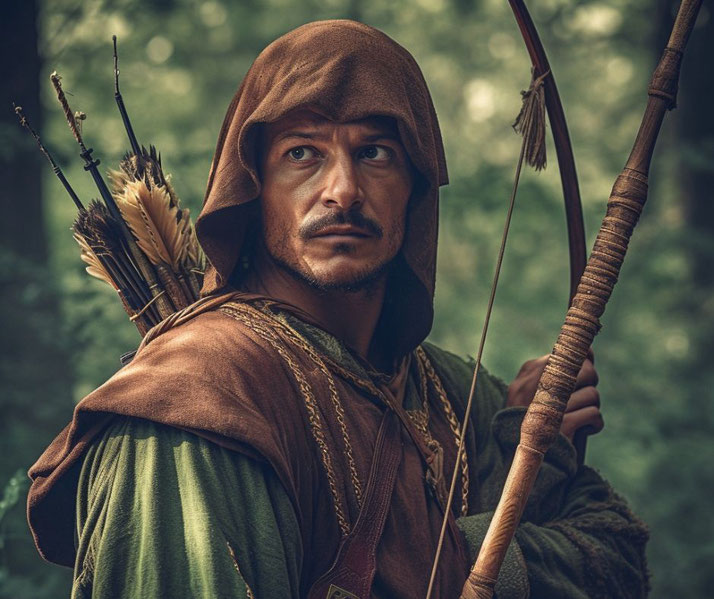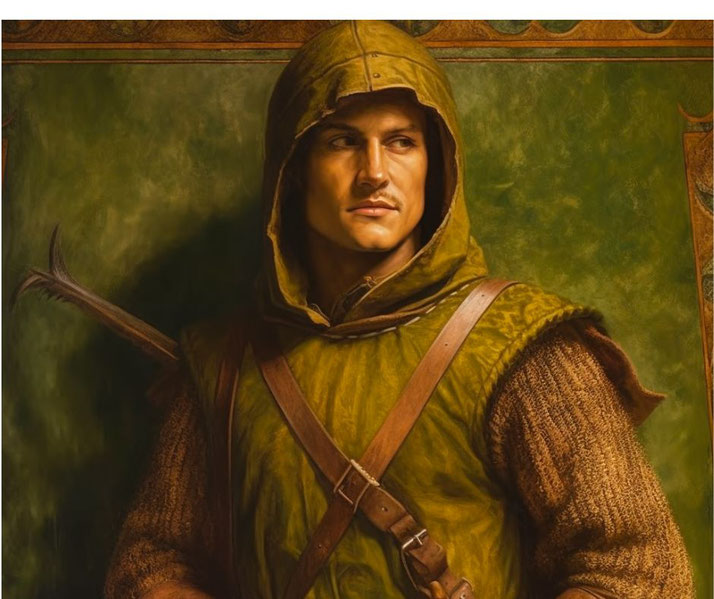Was there ever a real Robin Hood?

Robin Hood, the legendary outlaw hero of English medieval folklore, has captured the global imagination for centuries.
Known for his distinctive green attire, exceptional skill with a bow, and his noble cause of robbing the rich to feed the poor, Robin Hood's tale has been retold and adapted countless times across diverse cultures, languages, and mediums.
But behind the fascinating legend lies an intriguing question that has puzzled historians and enthusiasts alike: was Robin Hood a real historical figure or a mythical invention?
Who is Robin Hood?
In most iterations of the tale, Robin Hood is portrayed as a highly skilled archer and swordsman.
His story is typically set during the reign of King Richard the Lionheart, in the late 12th and early 13th centuries, when England was experiencing significant societal and political changes.
Living as an outlaw in Sherwood Forest in Nottinghamshire, he is said to have led a band of merry men, including characters such as Little John, Friar Tuck, and Will Scarlet.
Often, he's depicted as a former nobleman who turned to a life of crime due to injustices perpetrated by the corrupt Sheriff of Nottingham and the absentee King John.
His noble birth, coupled with his outlaw status, creates a fascinating character contrast, making him a figure that transcends the traditional boundaries of class and social status.
Key elements of the legend
Robin Hood's most distinctive characteristic is his commitment to justice and the downtrodden.
His signature motto, "robbing from the rich to give to the poor," positions him as a champion of the common people, standing up against tyranny and corruption.
This trait, in particular, has allowed the legend to retain its popularity, as themes of social justice, rebellion against authority, and the fight for equality continue to resonate across the centuries.
The character's romantic interest, Maid Marian, is another key figure in the legend, although she doesn't appear in the earliest tales.
Over time, her character evolved from a high-born noblewoman to a more active participant in Robin Hood's adventures, reflecting changing societal attitudes towards women and their roles in stories.
Finding evidence for Robin Hood
The legend of Robin Hood, although firmly established in popular imagination, does not have a clear, linear origin in historical records.
However, there are scattered references and potential hints of his existence in various historical and literary sources.
The earliest mention of a character named Robin Hood appears not in historical records, but in a series of late-medieval ballads, the earliest of which dates back to the 14th century.
These include the "Robin Hood and the Monk," "Robin Hood and the Potter," and "A Gest of Robyn Hode."
These ballads depict a character already fully formed as an outlaw living in Sherwood Forest, who steals from the rich and helps the less fortunate.
Notably, the context and details of these early ballads vary significantly from the modern, popular versions of the legend, suggesting an evolution of the character and his story over time.

The earliest references to the name
In terms of historical records, the earliest known reference to 'Robin Hood' appears in a series of English legal documents from the late 13th and early 14th centuries.
These documents use 'Robinhood,' 'Robehod,' or 'Rabunhod' as generic names for criminals.
While intriguing, these references are considered by most scholars to be pseudonyms used for outlaws or criminal defendants rather than proof of the existence of a specific individual named Robin Hood.
Further potential references can be found in literary works like William Langland's "Piers Plowman" from the late 14th century, which mentions 'rhymes of Robin Hood,' suggesting that the character was well known in oral tradition by this time.
Similarly, in the 15th century, the Scottish historian Walter Bower refers to the outlaw in his work "Scotichronicon," providing an early third-party recognition of the legend.
However, none of these references provide definitive proof of a historical Robin Hood, instead offering tantalizing hints of a figure or figures that might have inspired the legend.
The real challenge, then, is to parse these references and investigate further to determine whether they could be evidence of a real Robin Hood or merely instances of a popular character being used symbolically or allegorically in various cultural contexts.
The real origins of the legend
Given the first literary mentions of Robin Hood appear in late-medieval ballads, it's plausible that the character arose from an oral tradition of storytelling.
Folktales and oral histories were a common means of entertainment and cultural transmission in the Middle Ages, often featuring outlaws and rebels as heroic figures.
Robin Hood, with his embodiment of defiance against authority and justice for the poor, would have been a fitting protagonist for such tales.
Over time, these stories might have been embellished and modified, eventually solidifying into the well-known legend.
A prevalent theory posits that the Robin Hood legend may have been inspired by real outlaws from the medieval period.
During the 12th and 13th centuries, England underwent significant societal upheaval, with increasing wealth disparity and political corruption.
The figure of an outlaw who stood up to these injustices would have been appealing, possibly leading to the creation and popularization of a character like Robin Hood.
Celtic origins?
Some scholars argue that the legend might have its roots in myth and folklore, pointing to parallels between Robin Hood and characters from Celtic and Germanic mythology.
Certain aspects of Robin Hood, such as his exceptional skill with a bow and his connection to the forest, mirror attributes of mythological figures like the Celtic god Cernunnos or the Germanic archer god Ullr.
This suggests the possibility of Robin Hood being a folkloric archetype, repurposed and adapted to fit the socio-political climate of medieval England.
Furthermore, there's also the hypothesis that Robin Hood was initially a personification of the May Games, a popular folk festival in medieval England that often featured archery contests and other festivities associated with Robin Hood in later periods.
Over time, the character associated with these celebrations might have been imbued with more backstory and character traits, developing into the Robin Hood of legend.
Real historical people who could be Robin Hood
Over the centuries, numerous theories have been proposed about the real historical figures who might have served as the inspiration for the character of Robin Hood.
However, the lack of definitive historical evidence has left this field open to conjecture and lively debate.
One of the earliest theories focuses on an outlaw named Roger Godberd, who was active in the 1260s during the reign of King Henry III.
Godberd was a dispossessed landowner and a notable rebel against royal authority, with a series of exploits that bear striking similarities to the Robin Hood legend.
His base of operations was Sherwood Forest, further fueling speculation. However, the timeframe of Godberd's activities is much later than traditionally associated with Robin Hood, leaving some historians skeptical.

Another prominent theory involves Robert of Wetherby, an outlaw active during the reign of King Edward II in the early 14th century.
Robert was declared an outlaw for killing a man in Wakefield, and like Godberd, his lifetime falls outside the conventional timeframe for Robin Hood. However, the similarity in their names and outlaw status makes Robert a compelling candidate.
The most widely accepted theory centers around the historical figure of Robert Hod (or Hood), also known as Hobbehod.
Robert was a fugitive in the early 13th century who resided in the region of Yorkshire.
The coinciding timeframe, geographic location, and the similarity of the name make this theory appealing to many historians.
Despite these potential candidates, no historical figure has been definitively linked to Robin Hood.
The presence of numerous 'Robin Hoods' in historical documents and the common usage of the name as a generic term for outlaws make it challenging to pin down a single, real-life inspiration for the character.
Whether Robin Hood was based on one of these figures, a composite of several, or entirely fictional, remains an open question, adding yet another layer of mystery to the enduring legend.
What do you need help with?
Download ready-to-use digital learning resources
Copyright © History Skills 2014-2024.
Contact via email
With the exception of links to external sites, some historical sources and extracts from specific publications, all content on this website is copyrighted by History Skills. This content may not be copied, republished or redistributed without written permission from the website creator. Please use the Contact page to obtain relevant permission.





